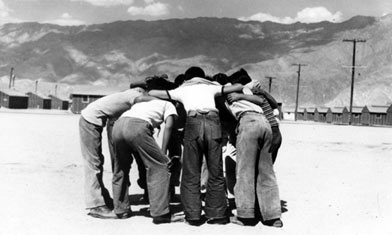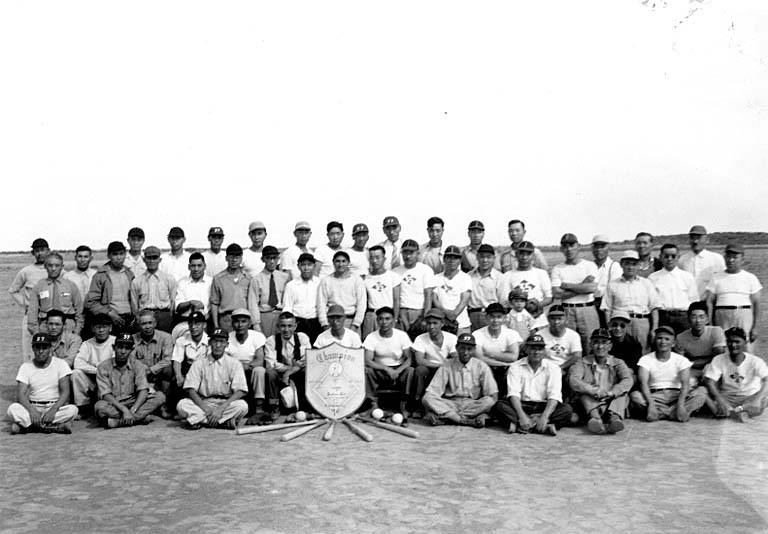Recreation Inside of the Fence |
||
A great majority of older men did not have many opportunities or shunned them deliberately. They took little jobs that carried no responsibility and demanded a minimum amount of time such as janitors or helpers in the mess halls. With an abundance of free time many sat around and talked. Some spent a great deal of time carving wood. A lot of older men spent most of their time playing go (a Japanese game much like checkers), cards, or baseball. (Spicer, Hansen, Luomala, & Opler, 1969, p.217-218) The older men especially enjoyed baseball. Every center had block teams composed of Issei and most centers had "Old Men's Leagues". All during the summer they played or went to the several diamonds in the centers and watched and rooted in Japanese-English for their teams. Entire Sundays were spent at baseball games and entire evenings devoted to discussing the games. (Spicer, Hansen, Luomala, & Opler, 1969, p.219) For young and old alike baseball made prison life more liveable. For some the news of forming a baseball league was the best thing they had heard of since they had got off the train and entered the camp. It gave them something to look forward to and made them feel good about themselves again. Baseball brought together the Issei and Nisei who had not always seen eye to eye since they began relocation. Baseball was something the entire family could enjoy together. "Obachan (grandmother) loved baseball, and they got busy going to baseball games and watching baseball games." (Tateishi, 1984, p. 13) Baseball brought much joy to the internment camps. Baseball diamonds were built, even though the players faced a constant battle with the wind which would create sudden dust storms. Usually these storms would end afternoon games. Hundreds showed up for the games and more were always to be expected. (Stanley, 1994, p.74) At the 10 camps administered by the U.S. government, Japanese-Americans clung to vestiges of their prewar lives to help them survive a humiliating ordeal. Behind the barbed wire, playing and watching baseball became an important daily activity. Prisoners organized teams in each camp, replicating the Japanese-American leagues that flourished in California, Hawaii, Oregon, and Washington during the 1920s and 1930s. (Davis, Cook & O'Brien, 1998) Amid these harsh conditions, an unlikely hero emerged: Kenichi Zenimura. He was born in Hiroshima in 1900 and immigrated to Hawaii with his parents in 1907. It was there he acquired his love of the game. He took this love with him when he moved to Fresno, California in 1920. He organized the Fresno Athletic Club, a Japanese-American baseball team, and directed the construction of a wooden stadium. He also led Japanese-American all-star teams on trips to Japan in 1924, 1927, and 1937. Zenimura and his family were sent to the Fresno County Fairgrounds and then to Gila River Relocation center in Arizona. (Davis, Cook & O'Brien, 1998) Zenimura envisioned a baseball stadium, complete with bleachers, dugouts and an outfield wall. He drafted his sons to help with the laborious creation. The first step was to tame the weed-filled desert behind the barracks of Block 28. Soon lots of people were coming with shovels to help clear the area. Work continued until they had two dugouts and a small grandstand. (Davis, Cook & O'Brien, 1998) On March 7, 1943, Zenimura Field opened for play. Kenichi had organized 32 teams into three divisions, and games were scheduled in the early evening to avoid the desert heat. According to historian Kerry Yo Nakagawa, director of the Nisei Baseball Research Project, the equipment the ballplayers used was primitive. Wooden blocks were sunk into the ground for home plate and the pitcher's rubber (eventually Kenichi was able to get a real pitcher's rubber and a home plate), and some of the uniforms were sewn from mattress ticking. The bases were hand-sewn bags filled with rice, while the foul lines were drawn with flour from the mess hall. (Davis, Cook & O'Brien, 1998) Fans flocked to Zenimura Field, and they dropped donations into a coffee can placed at the entrance. This allowed Kenichi to purchase bats, balls, bases and uniforms by mail from a sporting goods store back in Fresno. The crowds never stopped coming, and the fans who couldn't find space in the bleachers would stand along the foul lines. The baseball diamond became a social hot spot. Adults and teenagers would gather every night to watch the games. (Davis, Cook & O'Brien, 1998) "Baseball, says Howard Zenimura, was the only thing that kept us going. If we didn't play baseball, (camp life) would've been unbearable. Even when we didn't play, we were out there watching." (Davis, Cook & O'Brien, 1998) In 1945 in a letter thanking Gila River internees for their support, (Zenimura) wrote of the healing power of baseball: "I will be returning to Fresno and while I am there will try to make a team to play in the league in the city, to try to speed up the mutual feeling between the Americans and the Japanese." "Zenimura and others created a fraternal community in the desert-and baseball was a glue." (Davis, Cook & O'Brien, 1998) Watch these awesome videos to learn more about baseball inside of the barbed wire fence. |
 Boys in a huddle during a baseball game. Photograph by Dorothea Lange, courtesy of the National Archives. Retrieved from: http://americanhistory.si.edu/ourstory/activities/internment/more.html   Minidoka Relocation Center, softball team, ca. 1943-1945 Retrieved from: http://content.lib.washington.edu/cdm4/item_viewer.php?CISOROOT=/social&CISOPTR=130&CISOBOX=1&REC=1
Additional information: (Click on links for more information.) Baseball Flourished at Japanese Internment Camp by Richard Ruelas Click here: http://www.azcentral.com/travel/articles/2011/04/08/20110408ken-zenimura-baseball-japanese-internment-camp.html NISEI: The Early Japanese-American Ballplayers by Charlie Vascalleros Click here: http://www.thediamondangle.com/archive/aug01/nisei.htmlGila River Relocation Center: Click here: |
|